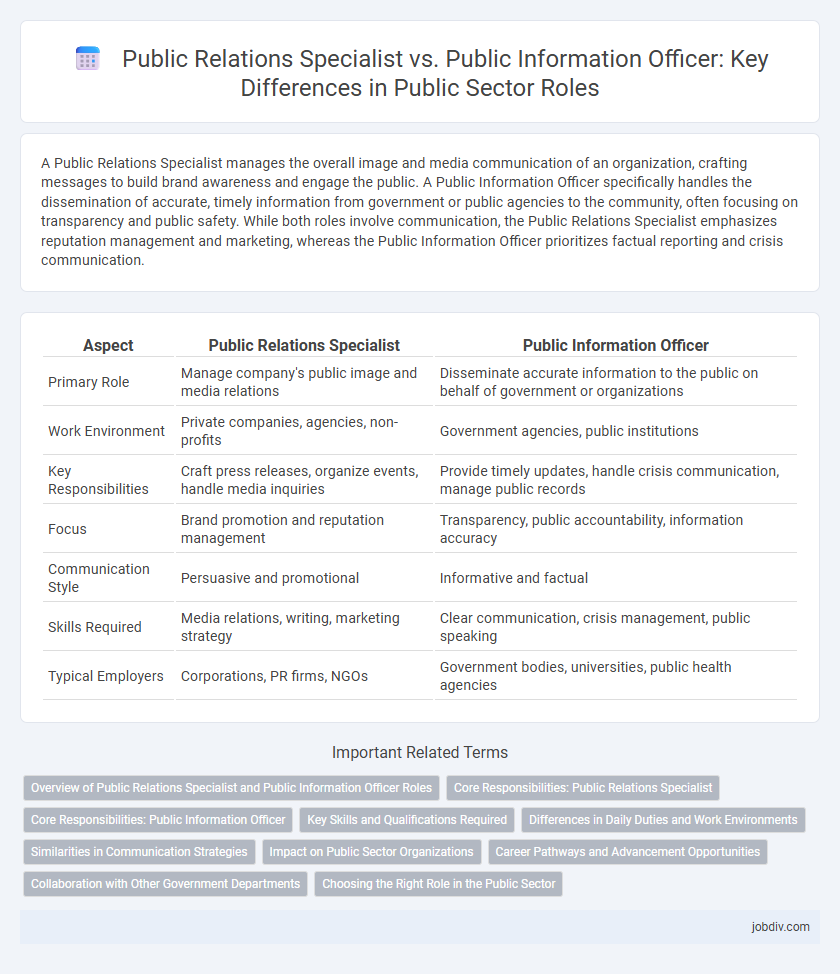A Public Relations Specialist manages the overall image and media communication of an organization, crafting messages to build brand awareness and engage the public. A Public Information Officer specifically handles the dissemination of accurate, timely information from government or public agencies to the community, often focusing on transparency and public safety. While both roles involve communication, the Public Relations Specialist emphasizes reputation management and marketing, whereas the Public Information Officer prioritizes factual reporting and crisis communication.
Table of Comparison
| Aspect | Public Relations Specialist | Public Information Officer |
|---|---|---|
| Primary Role | Manage company's public image and media relations | Disseminate accurate information to the public on behalf of government or organizations |
| Work Environment | Private companies, agencies, non-profits | Government agencies, public institutions |
| Key Responsibilities | Craft press releases, organize events, handle media inquiries | Provide timely updates, handle crisis communication, manage public records |
| Focus | Brand promotion and reputation management | Transparency, public accountability, information accuracy |
| Communication Style | Persuasive and promotional | Informative and factual |
| Skills Required | Media relations, writing, marketing strategy | Clear communication, crisis management, public speaking |
| Typical Employers | Corporations, PR firms, NGOs | Government bodies, universities, public health agencies |
Overview of Public Relations Specialist and Public Information Officer Roles
A Public Relations Specialist manages communication strategies to build and maintain a positive public image for organizations, focusing on media relations, press releases, and brand messaging. A Public Information Officer primarily serves as the official spokesperson for government agencies or public institutions, ensuring accurate dissemination of information during emergencies or routine updates. Both roles require strong communication skills but differ in audience focus and organizational objectives.
Core Responsibilities: Public Relations Specialist
Public Relations Specialists manage a company's or organization's public image by developing media strategies, writing press releases, and coordinating promotional events to foster positive relationships with the public and stakeholders. They analyze audience demographics and media trends to tailor communications that enhance brand reputation and visibility. Core responsibilities also include crisis management communication and monitoring media coverage to proactively address potential issues.
Core Responsibilities: Public Information Officer
Public Information Officers (PIOs) specialize in managing and disseminating information from government agencies, emergency services, or public institutions to ensure clear communication with the public and media. Their core responsibilities include crafting official statements, coordinating press releases, handling crisis communication, and serving as authoritative spokespersons. PIOs also monitor public sentiment and maintain transparency by providing timely updates during emergencies or public events.
Key Skills and Qualifications Required
Public Relations Specialists require strong communication skills, media relations expertise, and proficiency in crafting persuasive messages to shape public perception. Public Information Officers need a solid background in crisis communication, government or organizational policy knowledge, and the ability to disseminate accurate, timely information to the public and media. Both roles demand excellent interpersonal skills, strategic thinking, and proficiency in digital communication platforms.
Differences in Daily Duties and Work Environments
Public Relations Specialists focus on building and maintaining a positive public image for organizations through media campaigns, press releases, and social media engagement, often working in corporate or agency settings. Public Information Officers primarily serve government agencies or public institutions, managing timely and accurate dissemination of official information, responding to inquiries, and coordinating communication during crises. While PR Specialists emphasize brand promotion and reputation management, PIOs prioritize transparency, public safety, and compliance within structured, often bureaucratic work environments.
Similarities in Communication Strategies
Public Relations Specialists and Public Information Officers both utilize strategic communication to shape public perception and manage an organization's reputation through media relations, press releases, and social media engagement. Their communication strategies emphasize transparency, consistency, and timeliness to ensure accurate and positive information dissemination. Both roles prioritize stakeholder engagement, crisis communication, and maintaining a strong public image across various platforms.
Impact on Public Sector Organizations
Public Relations Specialists enhance the reputation of public sector organizations by crafting strategic communication campaigns that engage diverse audiences and manage stakeholder relationships effectively. Public Information Officers serve as official spokespersons, ensuring transparent, timely dissemination of information to the public and media, which strengthens trust and accountability in government operations. Both roles are critical in shaping public perception and facilitating open communication channels within government agencies.
Career Pathways and Advancement Opportunities
Public Relations Specialists typically advance by honing media relations, content creation, and brand management skills, progressing to senior communication roles or agency leadership. Public Information Officers often move through government or institutional ranks, gaining expertise in crisis communication, policy briefing, and community engagement, leading to director positions or public affairs management. Both careers emphasize strategic communication but diverge in sector-specific knowledge, affecting advancement opportunities and career trajectories.
Collaboration with Other Government Departments
Public Relations Specialists often collaborate with multiple government departments to craft unified communication strategies and manage public perception across various platforms. Public Information Officers serve as primary liaisons between government entities and the public, ensuring accurate dissemination of information and coordinating responses during public events or emergencies. Their joint efforts enhance transparency, streamline message consistency, and improve interdepartmental coordination within government operations.
Choosing the Right Role in the Public Sector
Public Relations Specialists craft strategic communication plans to enhance organizational reputation, emphasizing media relations and audience engagement. Public Information Officers manage the dissemination of official information, ensuring transparency and accuracy in government communications. Selecting the right role depends on whether the focus is on proactive brand promotion or regulatory information distribution within the public sector.
Public Relations Specialist vs Public Information Officer Infographic

 jobdiv.com
jobdiv.com